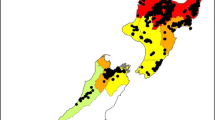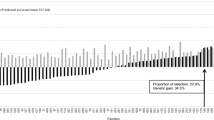Abstract
Open pollinated progenies from 15 clones of Japanese black pine (Pinus thunbergii), that had been selected for their tolerance to pine wilt disease, were tested by artificial inoculation with pine wood nematode for six years at a nursery of Kyushu Regional Breeding Office. Family variations in the respective year were all significant. An analysis of variance across the six years’ tests confirmed highly significant effect of year and of families; however, the year by family interaction was significant also. Phenotypic and genetic variances estimated from each year’s result were fitted to a quadratic regression using their mean survival ratio as an independent variable. The variances were greatest at around 0.5 of the mean survival ratio. Estimated heritability showed a similar trend of change, whereas the peak of the expected amount of improvement shifted toward the lower survival range: around 0.4, where a greater selection differential was anticipated. It was concluded that a useful amount of genetic improvement that may be reduced by 30% due to the interaction, would be expected by prescreening seedlings where the mean survival ratio after inoculation was around 0.25 to 0.6.
Similar content being viewed by others
Literature cited
Akasi, T., Kasuya, S., Kitamura, K., and Kanazashi, A. (1991) Selection effectiveness of resistance to the pine-wilt disease and a method of estimating it. J. Jpn. For. Soc. 73: 46–49.
Falconer, D.S. (1981) Introduction to quantitative genetics. 2nd ed., 340pp, Longman Scientific & Technical, Essex, UK.
Fujimoto, Y., Toda, T., Nishimura, K., Yamate, H., and Fuyuno, S. (1989) Breeding project on resistance to the pine wood nematode: An outline of the research and the achievement of the project for ten years. Bull. Forest Tree Breed. Inst. 7: 1–84.
Harvey, W.A. (1979) Least squares analysis data with unequal subclass numbers. U.S. Dept. Agric. Res. 157pp. Reprinted.
Lilliefors, H.W. (1967) On the Kolmogorov-Smirnov test for normality with mean and variance unknown. J. Am. Stat. Assoc. 62: 399–402.
Sokal, R.R. and Rohlf, F.J. (1969) Introduction to biostatistics. 368pp, W.H. Freeman, San Francisco.
Son, S.-I. and Goddard, R.E. (1979) Influence of infection percent on improvement of fusiform rust resistance in slash pine. Silvae Genet. 28: 173–180.
Toda, T. (1996) Resistance breeding of Japanese pine species to pine wood nematode. Forest Pests 45: 2–7.
Toda, T. (1997) Resistance breeding of Japanese pine species to pine wilt disease.In Pine wood nematode: Historical background and current progress of the research. 274pp, Association of Forest Pest and Diseases, Tokyo.
Toda, T. and Kurinobu, S. (1998) Current status of resistance breeding of Japanese pine species to pine wilt disease. Proc. Int. Symp. Sustain. Pine Forests Relation Pine Wilt Decline: 208–212.
Wright, J.W. (1976) Introduction to forest genetics. 463pp, Academic Press, New York.
Yamada, Y. (1962) Genotype by environment interaction and genetic correlation of the same trait under different environments. Jpn. J. Genet. 37: 498–509.
Author information
Authors and Affiliations
Corresponding author
About this article
Cite this article
Toda, T., Kurinobu, S. Genetic improvement in pine wilt disease resistance inPinus thunbergii: The effectiveness of pre-screening with an artificial inoculation at the nursery. J For Res 6, 197–201 (2001). https://doi.org/10.1007/BF02767093
Accepted:
Issue Date:
DOI: https://doi.org/10.1007/BF02767093




